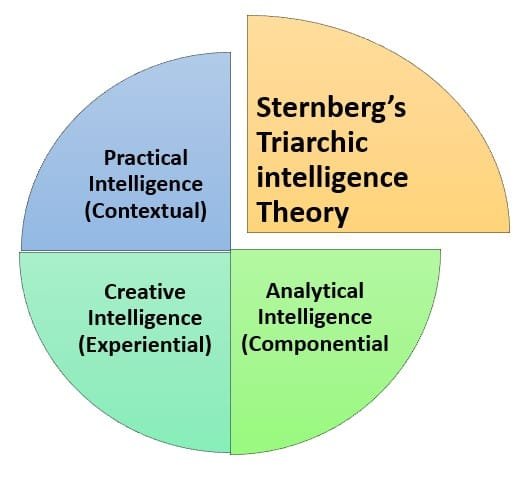Introduction to Theories of Intelligence
What exactly is intelligence? Is it a single, measurable trait, or does it exist in multiple forms? Over time, psychologists have developed various theories of intelligence to explain how people think, learn, and solve problems. From Spearman’s idea of a general intelligence (g-factor) to Sternberg’s triarchic theory of intelligence, the concept has evolved to include cognitive, creative, and practical abilities.
Definition of Intelligence
According to David Wechsler (1944), “it is the aggregate or global capacity of the individual to act purposefully, to think rationally and to deal effectively with the environment.”
Learn About More Definitions of Intelligence
1. Spearman’s General Intelligence (g)
In the early 20th century, Charles Spearman proposed that there is one general factor underlying all cognitive abilities, called “g factor”. Each cognitive task is influenced by this general intelligence factor.
“g factor” vs. “s factor”:
- “g”: General Intelligence. It is the quality or capacity of an individual as a whole. It is like the common thread running through all intellectual tasks.
- “s”: Specific Abilities. These refer to the specific abilities involved in distinct tasks. Each of these is unique to a specific task.
Analogy: General intelligence is like the car engine, while specific skills are the other parts of the car (like the wheels, steering, and so on). A good engine should normally lead to reasonably good functioning irrespective of the other parts.
Implications: Fitting into the hierarchical model of intelligence; “g” sits at the top affecting the other abilities.
Criticisms: Criticized for oversimplifying intelligence’s complexity. This assumption really can’t account for human ability variation and the notion that skills can be relatively independent.
2. Thurston’s Primary Mental Abilities
Louis Thurston challenged the idea of “g” by Spearman and insisted on a number of distinct primary mental abilities. He believed intelligence comprises a cluster of independent factors, not a single general factor.
Seven Primary Abilities: By means of factor analysis, Thurston defined seven relatively independent primary mental abilities:
- Verbal Comprehension (V): Understanding word meanings and relationships.
- Word Fluency (W): Rapid generation of words.
- Numerical Ability (N): Mathematical operations.
- Spatial Visualization (S): Mentally manipulating visual images.
- Associative Memory (M): Memorizing and recalling information.
- Perceptual Speed (P): Recognizing visually similar and different objects rapidly.
- Reasoning (R): Abstraction of general rules from specific instances.
Thesis of Independence: Thurstone argued that one or more of these abilities might be extremely good, while one or more of the other latent traits might be quite poor.
Example: High spatial visualization (S) versus lower verbal comprehension (V).
Implications: Made a shift from unitary general understanding to an existence of a profile of multiple abilities.
3. Structure of Intellect Theory by Guilford
Core Idea: J.P. Guilford proposed a three-dimensional model of intelligence called Structure of Intellect. The aim was to classify all possible intellectual things into categories.
Three-dimensional aspects: operations, contents, and products.
- Operations: The processes of thought performed by the mind- for example: cognition, memory, divergent productions, convergent productions, and evaluations.
- Contents: Information to be processed; that is, regarding the formulation of individual operations of a certain process: visual, auditory, symbolic, semantic, and behavioral.
- Products: The type arrangements of information (units, classes, relations, systems, transformations, implications).
Example: “Cognition of semantic relations” would mean understanding the relationship of word meanings.
Focus on Divergent Thinking: As influencing the development of creativity research, Guilford’s model laid as emphasis on its process-as opposed to the ideas it generates- more on divergent production than convergent.
Criticism: The huge complexity made it difficult to evaluate empirically.
4. Sternberg’s Triarchic Theory of Intelligence
Robert Sternberg allegedly suggested a triarchic theory whereby intelligence encompasses three different dimensions.
- Analytical Intelligence (Componential): It is responsible for analysis, evaluation, comparison, and contrast of information. It is the kind of intelligence that assesses IQ tests in a vintage way. It incorporates components of knowledge acquisition, performance components, and metacognitive components.
- Creative Intelligence (Experiential): The ability to develop, discover, and design original ideas or solutions. It relates to novelty and automatization (the act of causing some processes to become automatic).
- Practical Intelligence (Contextual): The ability to adapt to demands in everyday life, applying knowledge in everyday tasks, and shaping or selecting a situation or environment to fit one’s needs. Sometimes referred to as “street smarts.”

An example: Someone with very high practical intelligence may be much more successful at dealing with social contexts or dealing with conflict than someone who isn’t too highly scored on traditional IQ tests.
Implications: Taking the definition of intelligence beyond the academic ability into areas of open creativity and practicableness. It sheds light on how to interpret social intelligence in various contexts.
Learn more about :
Gardner’s Multiple Theory of Intelligence
Cattell’s Crystalline and Fluid Intelligence
Conclusion

Summary : theories of intelligence
References
- Ciccarelli, S, & White, J, N. (2017). Psychology. Global Edition, Pearson: libgen.lc
- egyankosh. Theories of Intelligence
Subscribe to Careershodh
Get the latest updates and insights.
Join 16,441 other subscribers!
Niwlikar, B. A. (2025, February 5). 4 Important Theories of Intelligence. Careershodh. https://www.careershodh.com/4-important-theories-of-intelligence/
